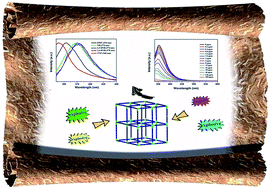A porous metal–organic framework formed by a V-shaped ligand and Zn(ii) ion with highly selective sensing for nitroaromatic explosives†
Abstract
A V-shaped aromatic ligand 1,3-di(4-carboxyphenyl)benzene (H2DCPB), retaining only one branch of the H6TDCPB ligand, was utilized. The assembly of this ligand with Zn(II) ions forms a two-fold interpenetrated porous MOF with pcu topology (JUC-135). The N2 adsorption isotherm of the activated sample at 77 K revealed type-I microporous characteristics. The BET and Langmuir surface areas are calculated to be 503.7 m2 g−1 and 718.9 m2 g−1, respectively. Notably, by the fluorescence technique, JUC-135 can be used to detect nitroaromatic explosives. In particular, it is one of the most efficient porous material-based sensors for TNP (KSV = 3.7 × 104 M−1). Furthermore, JUC-135 also can distinguish TNP (blue-shift) from NB, 1,3-DNB and 2,4-DNT (red-shift) by virtue of the shift direction of fluorescence spectra.


 Please wait while we load your content...
Please wait while we load your content...